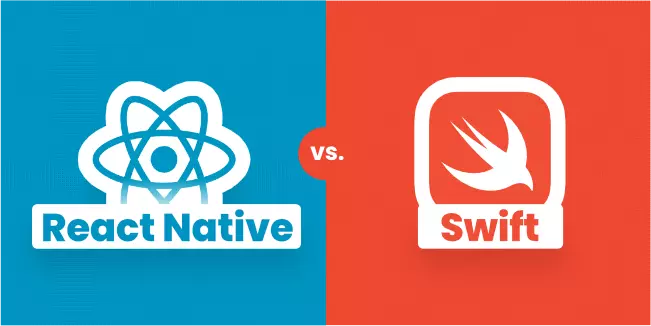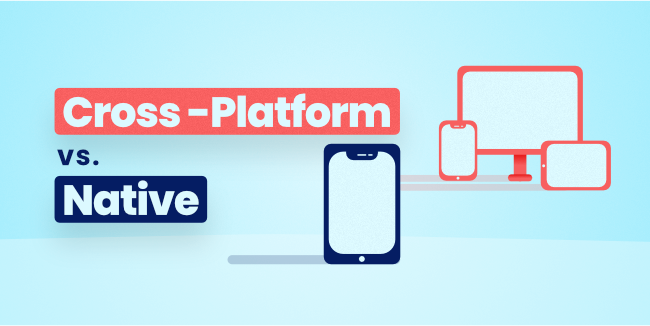Mobile Development
Technologies
reactnative
swift
iosdevelopment
React Native vs. Swift – A detailed comparison

There is no need to convince anyone about the necessity of mobile application development. Mobile applications have become part of our lives, and every company wants to have constant contact with the users of its products.
Due to the growing number of smartphone users, it is necessary to decide whether your application should be available on Android devices, iOS, or maybe on both of these systems. It means that you are probably considering choosing the proper framework and finding an offshore outsourcing company that will have experience and is your advisor. Choosing the proper partner is not easy, so we have prepared an article, "Choosing the right software partner - guide (2022)," from which you will learn what aspects are worth paying attention to satisfy the choice.
Swift and React Native are the newest platforms for creating mobile applications. Swift was developed by Apple, while React Native is a free Javascript Script framework developed by Facebook. This article compares both technologies to help you choose the best iOS app development platform.
What is React Native?
React Native is an open-source JavaScript framework created at Facebook in mid-2013. React Native was first introduced in March 2015, while the last stable version was released in November. It utilizes so-called "Native Modules" to create the apps with precompiled iOS and Android applications with native APIs for user interface components, which are being displayed on different devices.
React Native framework is most often used for multi platform mobile app development for the most popular mobile operating systems - Android and iOS. The React Native application has one code that works on Android and iOS apps. React Native is not completely native, like Swift iOS app development language. React Native acts as a mediator between the code and the iOS platform.
The Benefits of React Native
Performance
React Native is known for achieving high performance by relying on modules and native controls. RN uses Native APIs to write code that connects to the operating system's native components. React Native's superb performance is due to its ability to establish threads separate from the UIs and Native APIs. Although React Native may also utilize WebView, it reduces app performance considerably.
Modules
React Native is a framework that allows you to create native applications using JavaScript. React Native uses the concept of modules, which are reusable code chunks that can be mixed and matched to produce new apps. Furthermore, like Web APIs and reusable codes, the modules are also reusable. The flexibility of this approach and its ability to improve coordination and provide for smooth updates is one of the platform's most significant features. This function enables React Native developers to deploy app upgrades on the fly.
Hot Reloading

React Native developers can use this tool to see changes in an app's code right away in a preview window. This real-time information speeds up application development projects. Hot reloading makes the whole development process a lot more productive.
Quick App Updates
React Native has simplified the process of updating applications, eliminating the need to establish a different build process for each one. The OTA method, known as over-the-air updates (OTA), is quicker, easier, and more convenient for React Native developers and app users. This technique can even work if the application is in use. However, the functionality of the update is accessible after each app launch. In other words, users no longer need to download an app from the app store for it to work.
Cost-Efficient
It's straightforward to add new features to existing apps with React Native. All you have to do is include the UI components into an existing application rather than rebuilding it from the ground up. This functionality comes in handy when you want to expand an app's capabilities without rewriting it entirely.
Popularity and Community
Cross-platform mobile app development is becoming increasingly popular, and it's being utilized more frequently. It allows for even more rapid growth.
Great integration possibilities
React Native and Javascript codebases are already well established in the developers' community. The number of users is only increasing. React Native has broader integration possibilities with external programs than any other framework. It should also be mentioned that React Native compiles to the native code and can integrate with native APIs such as GPS or camera. Furthermore, third-party plugins - JavaScript or native ones - may be utilized too!
Top-notch user interface and user experience
One of the most appealing aspects of React Native is the User Interface developed. It is always quick and responsive, regardless of the platform. React Native enables your application to utilize native elements such as buttons, bars, and icons on the mobile design. Instead of separate components that work across both platforms, React Native considers native UI components and combines them with Javascript ones. The result? Apps appear and function like native mobile applications, giving a better user experience. The same screens on different platforms will differ by native UI elements.
The Limitations of React Native
Not Suitable for Intensive Apps
Resource-intensive apps should avoid using React Native. The native development method is preferable for applications that demand a lot of effort.
Loosely-Typed Language
React Native's use of JavaScript is advantageous, but it has a drawback. Because JavaScript is a typed language, it does not require the usage of particular variables and parameters in functions. In other words, a variable may contain anything at all. It poses a security concern.
Depends on Native Language
Developers must still write native modules to create functions not available in React Native. The native modules function as a link between the native code and React Native code. As a result, if you want to construct an app with React Native, you'll need to master native coding. Otherwise, you'll have to engage the services of a qualified expert.
Licensing and Patent Issues
React Native developers are mired in patent and licensing disputes. In addition to Facebook's Grant of Patent Right. The React Native License of 2017, which was recently updated, states that if you dispute Facebook's patent rights, you lose your right to use any of its open-source projects.
Long-Term Commitment Issues
A lack of long-term platform support is a concern. React Native isn't a turnkey solution or library; it requires ongoing maintenance to remain relevant for app creation. If Facebook stops supporting React Native, apps developed on the platform will become obsolete. Unfortunately, there is no alternative to React Native at this writing.
What is Swift? – An overview of Swift
Swift programming language has been created to build native app development. You can produce only native iOS apps for iOS, macOS, watchOS, tvOS, and Linux applications, thanks to this technology. Apple launched Swift in 2014. Backed by one of the world's most influential technology companies, Swift will soon become the dominant language for iOS development and beyond. But today, more and more companies choose cross-platform technologies to build their apps. It's designed to be a kind of sidekick for C-based languages. Swift is continuing to develop, and the community is getting bigger. Swift source code may be found on GitHub, making it simple for anybody to get hold of.
The Benefits of Swift
Fast Development
Development in Swift is quick because it is an expressive language that employs basic syntaxes. You can write less code to accomplish the same functions in Objective-C than in Swift. The Automatic Reference Counting ARC feature monitors and manages application memory usage. It saves a lot of time because memory tracking and management are no longer issues for developers who use Swift. As a result, apps developed utilizing Swift may be implemented faster.

Scalability and Safety and Performance Enhancement
The more features it has when working with a legacy code application, the better. With that in mind, we'll look at how to make your coding practices more secure and efficient by adding new functionality as your app grows. Swift was designed to compete with Objective C, and performance is a significant consideration in its design. It was claimed to be 40% faster when it was initially published. Several studies have backed up this assertion.
Safety Enhancement
In the case of production apps, 'Swift's strong type system and error-handling features assist in minimizing crashes. Because of its short feedback loop, developers can identify coding mistakes quickly and fix them. These characteristics improve the safety of Swift applications.
Minimal Memory Footprint
The dynamic libraries were immediately included in Swift. Because the libraries are kept separate from the code, they are only used when necessary. As a result, throughout the app project, you won't find the libraries.
Compatibility with Objective-C
In the same project, Swift and Objective-C may be used interchangeably. This functionality is useful when updating or expanding a large project. In other words, the developer can take advantage of the vast Objective-C codebase while using Swift for new feature demands. This characteristic allows apps to move effortlessly between platforms.
Opensource and Easy to Learn
The Swift open-source community is active and supportive of the platform. Despite its youth, developers have a wealth of material accessible on the Internet.
Full-Stack Capacities and Cross-Device Support
Swift has successfully made the switch to the cloud. Swift has improved because it enables front-end and back-end development, thanks to features like code sharing and reusability. Developers may create apps more quickly and efficiently.
The Limitations of Swift
It’s a Relatively New Language
Even when comparing it to the more modern Objective-C, which debuted in the 1980s, Swift is a relatively young programming language. Because Swift is still evolving, bottlenecks will almost certainly occur along the way. Additional tools, libraries, and other resources are available on well-established platforms for app development problems.
Small Community
Finally, the Swift open-source community is not as big or robust as others like Objective-C despite its fast development. As a result, experienced Swift experts are still in demand. This problem presents a difficulty for new developers seeking assistance.
Compatibility Challenges
The fact that Swift is not backward compatible is a significant problem. The newer version of Swift does not communicate with the previous versions. In other words, a project written in an earlier version of the language cannot be updated using a later release.
Limited Programmers
Even though Swift has grown rapidly, relatively few developers have this expertise. Finding a competent Swift developer might be difficult.
Mobile app development: Cross-Platform App Development vs. Native iOS Apps Development

Native development is more efficient than cross-platform development, but it's also more expensive to create. Cross-platform app development is ideal if you have a restricted budget to work with. You'll save around 30% - 40% because just one codebase will suffice for an app that runs on both Android and iOS.
Developers have been arguing about the advantages and disadvantages of Native vs. Cross-Platform applications for many years. The distinction between Native and Cross-platform solutions isn't just about performance; it also considers their usage scenarios and explores some benefits and drawbacks. See our native app development and cross-platform apps development to expand this topic.
React Native vs Swift – platform comparison
User Interface
- Because of its iOS-originated design, Apple's Swift is inherently compatible with the iOS aesthetic and applies all UX concepts. However, making native apps with Swift is from scratch because it is a new language. As a result, each aspect must be completed meticulously on its own.
- React Native is a JavaScript framework that uses internal APIs to execute native components. Because of this, the user interface is identical to the native one while being easier to write. Furthermore, React Native applications have no trouble adapting to various screen sizes because of JavaScript history, making it an excellent choice for building iPhone and iPad apps.
Speed of coding
- Swift is more concise, easier to understand, and less error-prone than Objective-C. The language took off the legacy of Objective-C, lowering complexity and eliminating limitations. It's a quick way to construct an iOS app from scratch.
- React Native is a framework for JavaScript that makes it easier to create sophisticated mobile applications. It's also simple to learn, and there have been numerous support solutions available since its inception in 1995.
Performance
With React Native, adding graphics effects is difficult. The framework supports the use of native codes in apps. This method allows developers to produce various assets and tools for managing development activities. In general, Swift applications run more efficiently than apps built with technologies. While the CPU requirements of Swift Apps are significant, they compare favorably to React Native applications in terms of performance, but not much better.
Time to the Market
- React Native is built on JavaScript; it uses its power and simplicity to create web apps. The language is simple to learn, and there are numerous online tools for developers. These elements come together to make React Native development a lot easier than it would be without them.
- Swift developers have fewer resources at their disposal than Objective-C developers do. The vast majority of projects would need to be completely rebuilt. Swift is quick owing to its lineage from the well-established Objective-C language. It's easier to create iOS apps using it, making it the ideal option for app development on iOS devices.
Stability
- Despite being based on one of the most popular programming languages, React Native doesn't produce a truly native application. It aims to utilize the platform's internal APIs and libraries to enable the software to function. As a result, it creates a layer between code and platform.
- On the other side, a native app written in Swift may take advantage of all platform features. As previously said, Swift performs better with graphic effects and computationally demanding operations. As a result, Swift may be preferable when juicing out the platform.
Documentation
- Both React Native and Swift are supported and maintained by tech giants. React Native is a Facebook-backed project, and Swift comes from Apple. Considering that, both projects are well-documented and organized. Both technologies deliver standards of commenting the code to be easily converted into documentation, significantly reducing the required time.
The maturity of the platform
- Both projects are still relatively new, being released in 2014 and 2015 (a direct descendant of React.js, which Facebook has used since 2011 and is now open source). These technologies are developing, but there are significant differences between them.
- The development of any program requires its own unique set of challenges. Swift is a new programming language that aims to be the next step after Objective-C.
- React Native, on the other hand, is a young technology that runs on JavaScript. As a result, debugging the framework is simpler, and finding its flaws is easier.
The cost of the development
- There appears to be very little difference in a single coder. There is little variation in coders' hourly pay, with better earnings for the fast development teams. Yet, they add up when dealing with a big project or several coders within the team. But if you're considering building an app for Android and iOS, React Native wins.
Popular Applications– React Native vs. Swift
What popular apps are made with React Native?
- Facebook
- Walmart
- Bloomberg
- Instagram
- SoundCloud
- Wix
What popular apps are made with Swift?
- SlideShare
- Airbnb
- Twitter
- American Airlines
- Lyft
A little tips
Choose Swift:
- Create apps with sophisticated user interfaces and memory management difficulties.
- Create applications for a single platform (iOS).
- Create applications that require native iOS features and APIs.
- Create apps that will need future maintenance upgrades.
- Create banking apps that require a lot of memory management and security.
Choose React Native:
- Develop an application that you may use to distribute on Android too.
- Develop a cost-effective application that is appropriate for your needs.
- Create an app that needs hot reloading and live reloading.
- Create software that requires a quick turnaround.
- Make a cross-platform program that can be used on any system.
Conclusion
React Native and Swift were created to create an excellent user experience on native platforms. Both have advantages and disadvantages. However, determining the winner for native iOS app development is difficult. If you need advice, contact our experts.
As a cross-platform mobile app development company, we are happy to share our knowledge and experience.